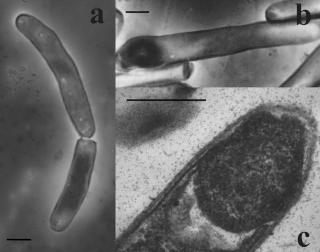Related Research Articles
A mesophile is an organism that grows best in moderate temperature, neither too hot nor too cold, with an optimum growth range from 20 to 45 °C. The optimum growth temperature for these organisms is 37°C. The term is mainly applied to microorganisms. Organisms that prefer extreme environments are known as extremophiles. Mesophiles have diverse classifications, belonging to two domains: Bacteria, Archaea, and to kingdom Fungi of domain Eucarya. Mesophiles belonging to the domain Bacteria can either be gram-positive or gram-negative. Oxygen requirements for mesophiles can be aerobic or anaerobic. There are three basic shapes of mesophiles: coccus, bacillus, and spiral.
The Aquificota phylum is a diverse collection of bacteria that live in harsh environmental settings. The name Aquificota was given to this phylum based on an early genus identified within this group, Aquifex, which is able to produce water by oxidizing hydrogen. They have been found in springs, pools, and oceans. They are autotrophs, and are the primary carbon fixers in their environments. These bacteria are Gram-negative, non-spore-forming rods. They are true bacteria as opposed to the other inhabitants of extreme environments, the Archaea.
The Thermomicrobia is a group of thermophilic green non-sulfur bacteria. Based on species Thermomicrobium roseum and Sphaerobacter thermophilus, this bacteria class has the following description:
Sulfur-reducing bacteria are microorganisms able to reduce elemental sulfur (S0) to hydrogen sulfide (H2S). These microbes use inorganic sulfur compounds as electron acceptors to sustain several activities such as respiration, conserving energy and growth, in absence of oxygen. The final product or these processes, sulfide, has a considerable influence on the chemistry of the environment and, in addition, is used as electron donor for a large variety of microbial metabolisms. Several types of bacteria and many non-methanogenic archaea can reduce sulfur. Microbial sulfur reduction was already shown in early studies, which highlighted the first proof of S0 reduction in a vibrioid bacterium from mud, with sulfur as electron acceptor and H
2 as electron donor. The first pure cultured species of sulfur-reducing bacteria, Desulfuromonas acetoxidans, was discovered in 1976 and described by Pfennig Norbert and Biebel Hanno as an anaerobic sulfur-reducing and acetate-oxidizing bacterium, not able to reduce sulfate. Only few taxa are true sulfur-reducing bacteria, using sulfur reduction as the only or main catabolic reaction. Normally, they couple this reaction with the oxidation of acetate, succinate or other organic compounds. In general, sulfate-reducing bacteria are able to use both sulfate and elemental sulfur as electron acceptors. Thanks to its abundancy and thermodynamic stability, sulfate is the most studied electron acceptor for anaerobic respiration that involves sulfur compounds. Elemental sulfur, however, is very abundant and important, especially in deep-sea hydrothermal vents, hot springs and other extreme environments, making its isolation more difficult. Some bacteria – such as Proteus, Campylobacter, Pseudomonas and Salmonella – have the ability to reduce sulfur, but can also use oxygen and other terminal electron acceptors.

Thermotoga is a genus of the phylum Thermotogota. Members of Thermotoga are hyperthermophilic bacteria whose cell is wrapped in a unique sheath-like outer membrane, called a "toga".
Thermoanaerobacter is a genus in the phylum Bacillota (Bacteria). Members of this genus are thermophilic and anaerobic, several of them were previously described as Clostridium species and members of the now obsolete genera Acetogenium and Thermobacteroides
Thermoanaerobacter brockii, formerly Thermoanaerobium brockii, is a thermophilic, anaerobic, spore-forming bacterium.
Thermoanaerobacter mathranii is a thermophilic, anaerobic, spore-forming bacteria.
Thermoanaerobacter pseudethanolicus is a thermophilic, strictly anaerobic, spore-forming bacteria that was first found at Yellowstone National Park in the United States. Because of its ability to efficiently ferment sugars, it is thought to be of potential use in producing industrial alcohol.
Thermanaeromonas toyohensis is a species of bacteria within the family Thermoanaerobacteraceae. This species is thermophilic, anaerobic, and can reduce thiosulfate. It was originally isolated from a geothermal aquifer more than 500 m below the surface of the Earth.
Tepidibacter is a genus of Gram-positive bacteria in the family Clostridiaceae.

Carboxydocella is a Gram-positive and obligate anaerobe bacterial genus from the family of Syntrophomonadaceae.
Brockia is a genus of thermophilic bacteria from the family of Thermoanaerobacteraceae, with one known species, an obligate anaerobe, spore-forming, rod-shaped microorganism.
Caldanaerobacter is a Gram-positive or negative and strictly anaerobic genus of bacteria from the family of Thermoanaerobacteraceae.
Mahella is a genus in the phylum Bacillota (Bacteria). The name Mahella derives from: New Latin feminine gender dim. noun Mahella, named in honour of the American microbiologist Professor R.A. Mah, for his important contribution to the taxonomy of anaerobes.
Anaerolineaceae is a family of bacteria from the order of Anaerolineales. Anaerolineaceae bacteria occur in marine sediments. There are a total of twelve genera in this family, most of which only encompass one species. All known members of the family are Gram-negative and non-motile. They also do not form bacterial spores and are either mesophilic or thermophilic obligate anaerobes. It is also known that all species in this family are chemoheterotrophs.
Thermanaerothrix is a bacteria genus from the family of Anaerolineaceae with one known species. Thermanaerothrix daxensis has been isolated from water from the Saint-Christophe spring in France.
Thermanaeromonas burensis is a species of Gram-positive, non-motile, endospore-forming bacteria belonging to the family Thermoanaerobacteraceae that was isolated from a low-permeability argillaceous rock layer, at a depth of 490 m, in northern France. This species is thermophilic, strictly anaerobic, halotolerant, and can reduce thiosulfate.
Thermobrachium is an obligate anaerobic, moderately alkaliphilic, thermophilic and proteolytic genus of bacteria from the family of Clostridiaceae with one known species.
The Ignavibacteriales are an order of obligately anaerobic, non-photosynthetic bacteria that are closely related to the green sulfur bacteria.
References
- ↑ Parte, A.C. "Thermanaeromonas". LPSN .
- ↑ Mori, K; Hanada, S; Maruyama, A; Marumo, K (2002). "Thermanaeromonas toyohensis gen. nov., sp. nov., a novel thermophilic anaerobe isolated from a subterranean vein in the Toyoha Mines". International Journal of Systematic and Evolutionary Microbiology. 52 (Pt 5): 1675–80. doi:10.1099/ijs.0.02201-0. PMID 12361273.